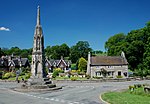Ilam Park

Ilam Park is a 158-acre (0.64 km2) country park situated in Ilam, on both banks of the River Manifold five miles (8 km) north west of Ashbourne, England, and in the ownership of the National Trust. The property is managed as part of the Trust's White Peak Estate. (Ashbourne, the 'post town', is in Derbyshire and thus so is Ilam's postal address, but the Park, and Ilam, are in Staffordshire the county boundary being the River Dove). The property consists of Ilam Hall and remnants of its gardens, an ancient semi-natural woodland — Hinkley Wood — designated as a Site of Special Scientific Interest (SSSI), noted for its small-leaved and large-leaved limes and their hybrids.
Excerpt from the Wikipedia article Ilam Park (License: CC BY-SA 3.0, Authors, Images).Ilam Park
The Oaks, Staffordshire Moorlands Ilam
Geographical coordinates (GPS) Address Nearby Places Show on map
Geographical coordinates (GPS)
| Latitude | Longitude |
|---|---|
| N 53.055 ° | E -1.807 ° |
Address
Ilam Hall overflow car park
The Oaks
DE6 2AZ Staffordshire Moorlands, Ilam
England, United Kingdom
Open on Google Maps







